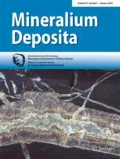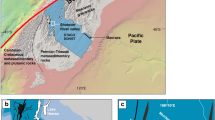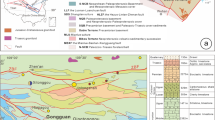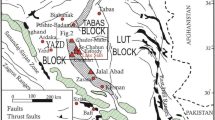Abstract
The source of metasomatic fluids in iron-oxide–copper–gold districts is contentious with models for magmatic and other fluid sources having been proposed. For this study, δ 18O and δ 13C ratios were measured from carbonate mineral separates in the Proterozoic eastern Mt Isa Block of Northwest Queensland, Australia. Isotopic analyses are supported by petrography, mineral chemistry and cathodoluminescence imagery. Marine meta-carbonate rocks (ca. 20.5‰ δ 18O and 0.5‰ δ 13C calcite) and graphitic meta-sedimentary rocks (ca. 14‰ δ 18O and −18‰ δ 13C calcite) are the main supracrustal reservoirs of carbon and oxygen in the district. The isotopic ratios for calcite from the cores of Na–(Ca) alteration systems strongly cluster around 11‰ δ 18O and −7‰ δ 13C, with shifts towards higher δ 18O values and higher and lower δ 13C values, reflecting interaction with different hostrocks. Na–(Ca)-rich assemblages are out of isotopic equilibrium with their metamorphic hostrocks, and isotopic values are consistent with fluids derived from or equilibrated with igneous rocks. However, igneous rocks in the eastern Mt Isa Block contain negligible carbon and are incapable of buffering the δ 13C signatures of CO2-rich metasomatic fluids associated with Na–(Ca) alteration. In contrast, plutons in the eastern Mt Isa Block have been documented as having exsolved saline CO2-rich fluids and represent the most probable fluid source for Na–(Ca) alteration. Intrusion-proximal, skarn-like Cu–Au orebodies that lack significant K and Fe enrichment (e.g. Mt Elliott) display isotopic ratios that cluster around values of 11‰ δ 18O and −7‰ δ 13C (calcite), indicating an isotopically similar fluid source as for Na–(Ca) alteration and that significant fluid–wallrock interaction was not required in the genesis of these deposits. In contrast, K- and Fe-rich, intrusion-distal deposits (e.g. Ernest Henry) record significant shifts in δ 18O and δ 13C towards values characteristic of the broader hostrocks to the deposits, reflecting fluid–wallrock equilibration before mineralisation. Low temperature, low salinity, low δ 18O (<10‰ calcite) and CO2-poor fluids are documented in retrograde metasomatic assemblages, but these fluids are paragenetically late and have not contributed significantly to the mass budgets of Cu–Au mineralisation.














Similar content being viewed by others
References
Baker T (2002) Emplacement depth and carbon dioxide-rich fluid inclusions in intrusion-related gold deposits. Econ Geol 97:1111–1117
Baker T, Perkins C, Blake KL et al (2001) Radiogenic and stable isotope constraints on the genesis of the Eloise Cu–Au deposit, Cloncurry District, Northwest Queensland. Econ Geol 96:723–742
Barton MD, Johnson DA (1996) Evaporitic-source model for igneous-related Fe oxide–(REE–Cu–Au–U) mineralization. Geology 24:259–262
Beardsmore TJ (1992) Petrogenesis of Mount Dore-style breccia-hosted copper + gold mineralisation in the Kuridala–Selwyn region of northwestern Queensland. Ph.D. thesis, James Cook University, Townsville, Australia
Blake DH (1987) Geology of the Mt Isa Inlier and environs, bulletin 225. Bureau of Mineral Resources, Geology and Geophysics, Canberra
Cannell J, Davidson GJ (1998) A carbonate-dominated copper–cobalt breccia–vein system at the Great Australia deposit, Mount Isa Eastern Succession. Econ Geol 93:1406–1421
Davidson GJ (1989) Starra and Trough Tank, iron-formation-hosted gold–copper deposits of north-west Queensland, Australia. Ph.D. thesis, University of Tasmania, Hobart
Davidson GJ, Davis BK (2001) Some controls on oxidation state variation of oxide Cu–Au systems. Geol Soc Am Abstr Prog 33(6):2
Davidson GJ, Dixon GH (1992) Two sulphur isotope provinces deduced from ores in the Mount Isa Eastern Succession, Australia. Miner Depos 27:30–41
Davidson GJ, Garner A (1997) Advances in the understanding of the Cloncurry Cu–Au field. In: Pollard PJ (ed) AMIRA P438: Cloncurry base metals and gold final report. Australian Mineral Industry Research Association, Townsville, pp 14-1–14-11
de Jong G, Williams PJ (1995) Giant metasomatic system formed during exhumation of mid-crustal Proterozoic rocks in the vicinity of the Cloncurry fault, northwest Queensland. Aust J Earth Sci 42:281–290
Des Marais DJ (2001) Isotopic evolution of the biogeochemical carbon cycle during the Precambrian. In: Valley JW, Cole DR (eds) Stable isotope geochemistry reviews in mineralogy and geochemistry, 43. Mineralogical Society of America, Washington, pp 555–578
Dixon G, Davidson GJ (1996) Stable isotope evidence for thermochemical sulfate reduction in the Dugald River (Australia) strata-bound shale-hosted zinc–lead deposit. Chem Geol 129:227–246
Farmer GL, De Paulo DJ (1997) Sources of hydrothermal components:heavy isotopes. In: Barnes HL (ed) Geochemistry of hydrothermal ore deposits, 3rd edn. Wiley, New York, pp 31–62
Fletcher C (1999) Geology, mineralization and metamorphism of the Plume prospect, Northwest Queensland. BSc (Honours) thesis, James Cook University, Townsville
Fortowski DB, McCracken SJA (1998) Mount Elliott copper–gold deposit. In: Berkman DA, Mackenzie DH (eds) Geology of Australian and Papua New Guinean deposits, AUSIMM monograph 22. Australian Institute of Mining and Metallurgy, Melbourne, pp 775–781
Gauthier L, Hall G, Stein H et al (2001) The Osborne deposit, Cloncurry District: a 1595 Ma Cu–Au skarn deposit. In: Williams PJ (ed) A hydrothermal odyssey extended conference abstracts—EGRU contribution 59. Economic Geology Research Unit, Townsville, pp 58–59
Giles D, MacCready T (1997) The structural and stratigraphic position of the Soldiers Cap Group in the Mount Isa Inlier. In: Ailleres L, Betts P (eds) Structural elements of the Eastern Successions, a field guide illustrating the structural geology of the eastern Mount Isa terrane, Australia. Australian Geodynamics Cooperative Research Centre, Melbourne, pp 61–73
Giles D, Nutman AP (2002) SHRIMP U–Pb monazite dating of 1600–1580 Ma amphibolite facies metamorphism in the southeastern Mt Isa Block, Australia. Aust J Earth Sci 49:455–466
Golyshev SI, Padalko NL, Pechenkin SA (1981) Fractionation of stable isotopes in carbonate systems. Geochem Int 10:85–99
Hand M, Rubatto D (2002) The scale of the thermal problem in the Mt Isa Inlier. In: Preiss VP (ed) Geoscience 2002: expanding horizons. Abstracts of the 16th Australian Geological Convention. Geological Society of Australia, Adelaide, pp 173
Haynes DW (2000) Iron oxide copper (–gold) deposits: their position in the ore spectrum and modes of origin. In: Porter TM (ed) Hydrothermal iron-oxide copper–gold & related deposits: a global perspective. Australian Minerals Foundation, Adelaide, pp 71–90
Haynes DW, Cross KC, Bills RT, Reed MH (1995) Olympic Dam ore genesis: a fluid mixing model. Econ Geol 90:281–307
Hingst R (2002) Geology and geochemistry of the Cloncurry Fault, north-west Queensland, Australia. BSc (Honours) thesis, James Cook University, Townsville
Krcmarov RL (1995) Proterozoic geology and mineralisation of the Greenmount Cu–Au–Co deposit, Cloncurry District. MSc thesis, University of Tasmania, Hobart
Lewis S, Holness M, Graham C (1998) Ion microprobe study of marble from Naxos, Greece: grain-scale fluid pathways and stable isotope equilibration during metamorphism. Geology 26:935–938
Little GA (1997) Structural evolution and paragenesis of alteration and mineralisation at the Mount Elliott Cu–Au mine, Northwest Queensland. BSc (Honours) thesis, James Cook University, Townsville
Mark G, Crookes RA (1999) Epigenetic alteration at the Ernest Henry Fe-oxide–(Cu–Au) deposit, Australia. In: Stanley et al (eds) Mineral deposits: processes to processing. Society for Geology Applied to Mineral Deposits (SGA), London, pp 185–188
Mark G, Foster DRW (2000) Magmatic–hydrothermal albite–actinolite–apatite-rich rocks from the Cloncurry District, NW Queensland, Australia. Lithos 51:223–245
Mark G, Oliver NHS, Williams PJ, Crookes R, Valenta R, Gow P (1999) Characteristics and origins of the Ernest Henry iron oxide–copper–gold hydrothermal system: results of the 1999 Collaborative SPIRT research project. James Cook University, Townsville
Marshall LJ (2003) Brecciation within the Mary Kathleen Group of the Eastern Succession, Mt Isa Block, Australia: implications of district-scale structural and metasomatic processes for Fe-oxide–Cu–Au mineralisation. Ph.D. thesis, James Cook University, Townsville
McCrae JM (1950) On the isotope chemistry of carbonates and a paleotemperature scale. J Chem Phys 18:849–857
Newberry SP, Carswell JT, Allnutt SL et al (1993) The Dugald River zinc–lead–silver deposit: an example of a tectonised Proterozoic stratabound sulphide deposit. In: Matther I (ed) World zinc ’93, AUSIMM publication series, v7. Australian Institute of Mining and Mettalurgy, Melbourne, pp 7–21
O’Dea MG, Lister GS, MacCready T et al (1997) Geodynamic evolution of the Proterozoic Mount Isa terrain. In: Burg J-P, Ford M (eds) Orogeny through time. Geological Society special publication no. 121, London, pp 99–122
O’Neil JR, Clayton RN, Mayeda TK (1969) Oxygen isotope fractionation in divalent metal carbonates. J Chem Phys 51:5547–5558
Ohmoto H, Rye RO (1979) Isotopes of sulphur and carbon. In: Barnes HL (ed) Geochemistry of hydrothermal ore deposits. Wiley, New York, pp 509–567
Oliver NHS, Wall VJ, Cartwright I (1992) Internal control of fluid composition in amphibolite–facies scapolitic calc-silicates, Mary Kathleen, Australia. Contrib Mineral Petrol 111: 94–112
Oliver NHS, Cartwright I, Wall VJ et al (1993) The stable isotope signature of kilometre-scale fracture-dominated metamorphic fluid pathways, Mary Kathleen, Australia. J Metamorph Geol 11:705–720
Oliver NHS, Mark G, Pollard PJ et al (2004) Geochemistry and geochemical modelling of fluid–rock interaction in the eastern Mt Isa Block, Australia: the role of sodic alteration in the genesis of iron oxide–copper–gold deposits. Econ Geol 99:1145–1176
Page RW, Sun S-S (1998) Aspects of geochronology and crustal evolution in the Eastern Fold Belt, Mt Isa Inlier. Aust J Earth Sci 45:343–361
Perring CS, Pollard PJ, Dong G et al (2000) The lightning creek sill complex, Cloncurry District, Northwest Queensland: a source of fluids for Fe oxide Cu–Au mineralization and sodic–calcic alteration. Econ Geol 95:1067–1089
Pollard PJ (2001) Sodic(–calcic) alteration in Fe-oxide–Cu–Au districts: an origin via unmixing of magmatic H2O–CO2–NaCl +–CaCl2–KCl fluids. Miner Depos 36:93–100
Porter S (1990) The Dugald River lead–zinc deposit. BSc (Honours) thesis, University of Queensland, Brisbane
Rotherham JF (1997) A metasomatic origin for the iron-oxide Au–Cu Starra orebodies, Eastern Fold belt, Mount Isa Inlier. Miner Depos 32:205–218
Rotherham JF, Blake KL, Cartwright I et al (1998) Stable isotope evidence for the origin of the Mesoproterozoic Starra Au–Cu deposit, Cloncurry District, northwest Queensland. Econ Geol 93:1435–1449
Rubenach M, Adshead N, Oliver NHS et al (2001) The Osborne Cu–Au deposit: geochronology, and genesis of mineralization in relation to host albitites and ironstones. In: Williams PJ (ed) A hydrothermal odyssey, extended conference abstracts, EGRU Contribution 59. Economic Geology Research Unit, Townsville, pp 172–173
Ryan AJ (1998) Ernest Henry copper–gold deposit. In: Berkman DA, Mackenzie DH (eds) Geology of Australian and Papua New Guinean deposits, AUSIMM monograph 22. Australian Institute of Mining and Metallurgy, Melbourne, pp 759–768
Sleigh DWW (2002) The Selwyn line tabular iron–copper–gold system, Mount Isa Inlier, NW Queensland, Australia. In: Porter TM (ed) Hydrothermal iron-oxide copper–gold & related deposits: a global perspective, vol 2. Australian Mineral Foundation, Adelaide, pp 77–93
Thorkelson DJ, Mortensen JK, Davidson GJ et al (2001) Early Mesoproterozoic intrusive breccias in Yukon, Canada: the role of hydrothermal systems in reconstructions of North America and Australia. Precambrian Res 11:31–55
Tullemans FJ, Agnew P, Voulgaris P (2001) The role of geology and exploration within the mining cycle at the Osborne Mine, northwestern Queensland. In: Edwards AC (ed) Mineral resource and ore reserve estimation: the AusIMM guide to good practice. Australiasian Institute of Mining and Metallurgy, Carlton, pp 157–168
Twyerould SC (1997) The geology and genesis of the Ernest Henry Fe–Cu–Au deposit, Northwest Queensland, Australia. Ph.D. thesis, University of Oregon
Valley JW (1986) Stable isotope geochemistry of metamorphic rocks. In: Valley JW, Taylor HP, O’Neil JR (eds) Stable isotopes in high temperature geological processes, reviews in mineralogy, vol 16. Mineralogical Society of America, Washington, pp 445–489
Wang S, Williams PJ (2001) Geochemistry and origin of Proterozoic skarns at the Mount Elliott Cu–Au(–Co–Ni) deposit, Cloncurry District, NW Queensland, Australia. Miner Depos 36:109–124
Weston R (2000) An overview of the structure, metamorphism, petrology, paragenesis and geochemistry of the Houdini Prospect, Cloncurry District, Mount Isa Inlier, NW Queensland. BSc (Honours) thesis, James Cook University, Townsville
Williams PJ (1998) Metalliferous economic geology of the Mt Isa Eastern Succession, Queensland. Aust J Earth Sci 45:329–341
Williams PJ, Skirrow RG (2000) Overview of iron oxide–copper–gold deposits in the Curnamona Province and Cloncurry District (eastern Mount Isa Block), Australia. In: Porter TM (ed) Hydrothermal iron-oxide copper–gold & related deposits: a global perspective. Australian Minerals Foundation, Adelaide, pp 105–122
Williams PJ, Dong G, Ryan CG et al (2001) Geochemistry of hypersaline fluid inclusions from the Starra (Fe oxide)–Au–Cu deposit, Cloncurry District, Queensland. Econ Geol 96:875–883
Xu G (2000) Methane-rich fluid inclusions in the Proterozoic Zn–Pb–Agdeposit at Dugald River, NW Queensland; potential as an exploration guide. Appl Geochem 15:1–12
Zheng Y-F (1999) Oxygen isotope fractionation in carbonate and sulfate minerals. Geochem J 33:109–126
Acknowledgements
This contribution stems from a Ph.D. research by LJM at James Cook University, funding for which was provided by JCU and the pmd*CRC. Logistical support was provided by MIM Exploration (now Xstrata Copper Australia). Ernest Henry Mining arranged access to drill core at the Ernest Henry deposit. The samples for isotopic analyses from the Mt Elliott and Eloise deposits are from the JCU research sample collection. Unpublished analyses from the Starra and Osborne deposits were collected by GJD. Geordie Mark is thanked for allowing the use of recent data from the Ernest Henry deposit. Ian Cartwright (Monash University) undertook the majority of new (and many of the previously published) isotopic analyses. Hans Machel and Jeff Lonnee (University of Alberta) are thanked for assistance with CL equipment. Kevin Blake (JCU) assisted with microprobe analyses. The interpretation of the data has benefited from input by Tim Baker, Ian Cartwright, Bin Fu, Greg Dipple, Geordie Mark, Andrew McCaig, Mike Roberts, Bruce Yardley and others. The comments on earlier versions of the manuscript by Derek Thorkelson, Stephen Cox and Louise Corriveau and constructive reviews by Richard Naslund and an anonymous reviewer are gratefully acknowledged.
Author information
Authors and Affiliations
Corresponding author
Additional information
Editorial handling: B. Gemmell
Rights and permissions
About this article
Cite this article
Marshall, L.J., Oliver, N.H.S. & Davidson, G.J. Carbon and oxygen isotope constraints on fluid sources and fluid–wallrock interaction in regional alteration and iron-oxide–copper–gold mineralisation, eastern Mt Isa Block, Australia. Miner Deposita 41, 429–452 (2006). https://doi.org/10.1007/s00126-006-0069-3
Received:
Accepted:
Published:
Issue Date:
DOI: https://doi.org/10.1007/s00126-006-0069-3




